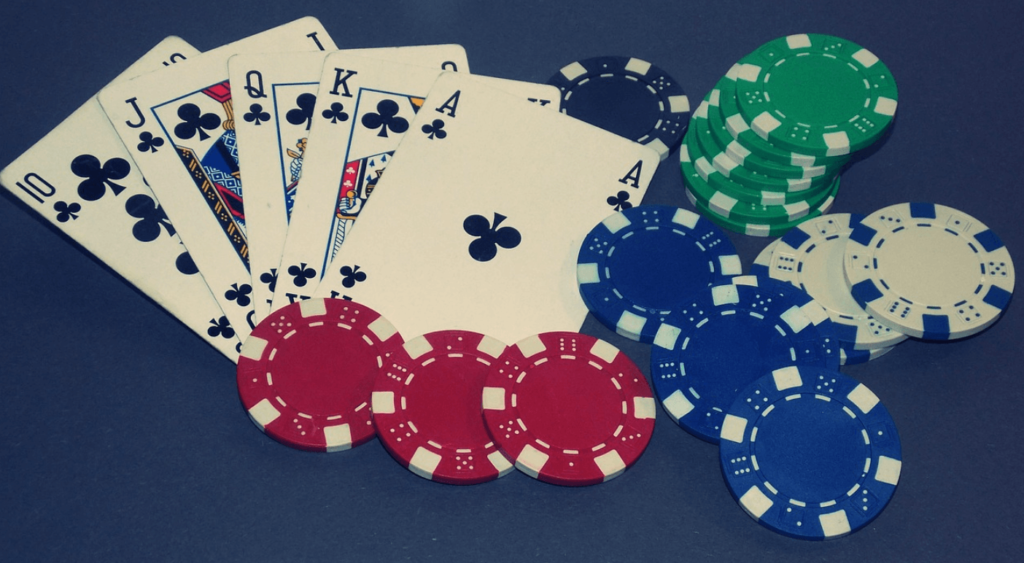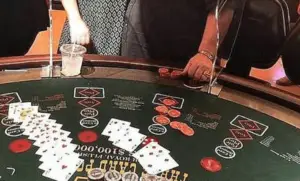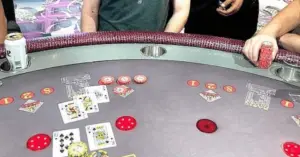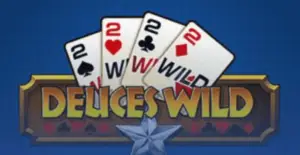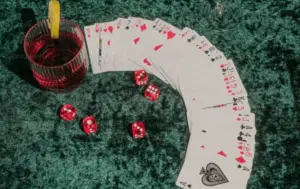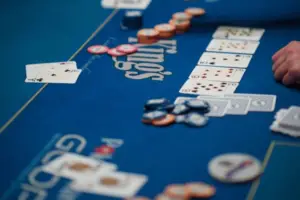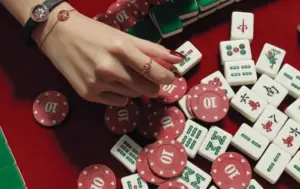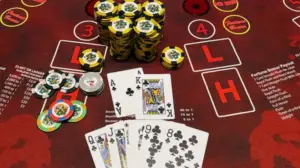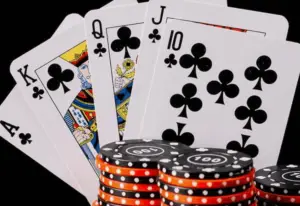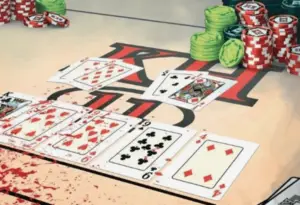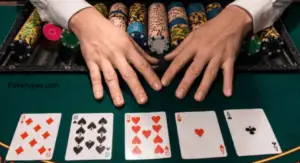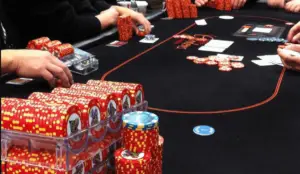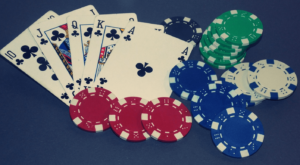Texas Hold’em is the most popular poker game in the world today. It’s a card game where players try to make the best five-card hand using two private cards and five shared cards on the table.
The game started in Texas in the early 1900s and has grown into a global phenomenon. Casinos, online poker sites, and home games all feature Texas Hold’em as their main attraction.
Its popularity exploded in the early 2000s when televised tournaments like the World Series of Poker started showing hole cards to viewers.
This made the game more exciting to watch and easier to understand. Now, millions of people play Texas Hold’em for fun and for big money.
It’s even considered a sport by some, with professional players becoming celebrities in their own right. The game’s mix of skill, strategy, and luck keeps players coming back for more.
Basic Rules and Gameplay
A. Objective of the game
The main goal in Texas Hold’em is to win the pot, which is all the money or chips that players bet during a hand. You can win the pot in two ways:
- Have the best hand at showdown
- Make a bet that no one else calls, causing everyone else to fold
To play Texas Hold’em, you need to know how to make the best five-card hand using your two private cards (called hole cards) and the five community cards on the table.
It’s not just about having good cards – you also need to outsmart your opponents and make them think you have a better hand than you do.
B. Card rankings and hand values
In Texas Hold’em, the 52-card deck is used, and the cards are ranked from highest to lowest: Ace, King, Queen, Jack, 10, 9, 8, 7, 6, 5, 4, 3, 2. The Ace can be high or low, meaning it can be used to make the highest straight (A-K-Q-J-10) or the lowest straight (5-4-3-2-A). Here are the poker hand rankings from best to worst:
- Royal Flush: A-K-Q-J-10 of the same suit
- Straight Flush: Five cards in sequence, all of the same suit
- Four of a Kind: Four cards of the same rank
- Full House: Three of a kind plus a pair
- Flush: Any five cards of the same suit, not in sequence
- Straight: Five cards in sequence, not of the same suit
- Three of a Kind: Three cards of the same rank
- Two Pair: Two different pairs
- One Pair: Two cards of the same rank
- High Card: When you haven’t made any of the hands above, the highest card plays
Remember, in Texas Hold’em, you’re trying to make the best five-card hand out of the seven cards available (your two-hole cards plus the five community cards).
C. Betting structures (limit, no-limit, pot-limit)
Texas Hold’em can be played with different betting structures. The three main types are:
Fixed Limit: In this structure, betting is done in fixed amounts. For example, in a $2/$4 limit game, bets and raises must be exactly $2 for the first two rounds of betting and $4 for the last two rounds.
No Limit: This is the most popular form of Texas Hold’em. In No Limit, a player can bet any amount up to all their chips at any time. This creates more excitement and bigger pots.
Pot Limit: In this structure, the maximum bet is the current size of the pot. For example, if the pot is $100, the maximum bet is $100.
Each betting structure changes how the game is played. No-Limit games tend to be more aggressive and exciting, while fixed-Limit games are more about math and playing the odds.
D. Blinds and dealer button
In Texas Hold’em, we use blinds and a dealer button to keep the game fair and create action. Here’s how they work:
The dealer button is a round disc that moves clockwise around the table after each hand. It shows who the dealer would be if we were dealing the cards ourselves.
The player to the left of the button posts the small blind, which is usually half the minimum bet.
The player to the left of the small blind posts the big blind, which is typically the minimum bet.
For example, in a $1/$2 game, the small blind would be $1 and the big blind would be $2.Blinds are forced bets that create action and give players something to fight for right from the start.
E. Dealing process
1. Hole cards
The dealing process in Texas Hold’em starts with each player being dealt two cards face down. These are called your hole cards or pocket cards. Only you can see and use these cards.
2. Community cards (flop, turn, river)
After the first round of betting, the dealer puts three cards face up in the middle of the table. This is called the flop. These are community cards that everyone can use to make their hand. After another round of betting, a fourth community card is dealt.
This is called the turn or Fourth Street. Finally, after one more round of betting, the last community card is dealt. This is called the river or fifth street.
By the end, there are five community cards on the table that all players can use along with their two-hole cards to make the best possible five-card hand.
F. Betting rounds
There are four betting rounds in Texas Hold’em:
Pre-flop: This happens right after players get their hole cards.
Flop: After the first three community cards are dealt.
Turn: After the fourth community card is dealt.
River: After the final community card is dealt.
In each round, players can choose to:
Check: Pass the action to the next player without betting (only if no one has bet yet).
Bet: Put chips into the pot.
Call: Match the current bet.
Raise: Increase the current bet.
Fold: Give up their hand and lose any chips they’ve already put in the pot.
The betting continues clockwise around the table until all players have either called the current bet or folded.
G. Showdown and determining the winner
If there’s more than one player left after the final betting round, we have a showdown. Here’s how it works:
- Players show their hands, starting with the last person to bet or raise.
- If no one bet on the river, the player closest to the left of the button shows first.
- Other players can choose to show their hands or muck (throw away without showing).
The player with the best five-card hand wins the pot. Remember, you can use any combination of your two-hole cards and the five community cards to make your best hand. If two or more players have the same hand, they split the pot equally.
This is called a tie or a chop. For example, if the community cards are A♠ K♠ Q♠ J♠ 10♣, and you have 2♥ 3♥ in your hand, your best hand would actually be the royal flush on the board (A♠ K♠ Q♠ J♠ 10♠).
In this case, you’d split the pot with anyone else still in the hand, because everyone has the same best five-card hand.
Step-By-Guide to Play Texas Hold’em
As mentioned earlier, Texas Hold’em is played with a standard 52-card deck and can accommodate anywhere from 2 to 10 players.
The primary goal is to make the best five-card poker hand using a combination of your two-hole cards and the five community cards dealt face-up in the center of the table. Here’s a step-by-step guide on how to play Texas Hold’em:
The Blinds:
This game starts with two forced bets called the “blinds” – the small blind and the big blind. These two bets are placed before any hole card is given to any player.
The player to the immediate left of the dealer button posts the small blind, which is typically half the size of the big blind. The player to the left of the small blind posts the big blind, which is the minimum bet for that particular game.
For example, in a $1/$2 No-Limit Texas Hold’em game, the small blind would be $1 and the big blind would be $2.
Dealing the Hole Cards:
After the blinds are posted, each player is dealt two cards face down, which are known as their “hole cards.” These are the only cards each player will receive that are not shared with the other players. Let’s say you are dealt the ♥K and ♠Q as your hole cards.
The Preflop Betting Round:
Starting with the player to the left of the big blind, each player has the option to fold (give up their hand), call the big blind (match the current bet), or raise (increase the bet).
This continues clockwise around the table until all players have either folded or put in an equal amount of chips.
In our example, the action folds to put you in the cutoff position. With your KQ, you decide to raise it to $6. The player in the big blind calls your raise.
The Flop:
After the pre-flop betting round is complete, three community cards are dealt face-up in the center of the table. This is known as “the flop. “Let’s say the flop comes ♥J ♦7 ♣2.
The Flop Betting Round:
Starting with the player to the left of the dealer button, each active player has the option to check (decline to bet when no one else has bet), bet (make a wager), or fold (give up their hand).
This continues clockwise around the table until all players have either folded or put in an equal amount of chips.
In our example, you check, and the player in the big blind bets $8. You decide to call the $8 bet.
The Turn:
After the flop betting round is complete, a fourth community card is dealt face-up. This is known as “the turn” or “Fourth Street. “Let’s say the turn card is the ♠5.
The Turn Betting Round:
Starting with the player to the left of the dealer button, each active player has the option to check (decline to bet when no one else has bet), bet (make a wager), or fold (give up their hand),.
This continues clockwise around the table until all players have either folded or put in an equal amount of chips. In our example, you check, and the player in the big blind checks behind you.
The River:
After the turn betting round is complete, a fifth and final community card is dealt face-up. This is known as “the river” or “Fifth Street. “Let’s say the river card is the ♥3.
The River Betting Round:
Starting with the player to the left of the dealer button, each active player has the option to check, bet, or fold. This continues clockwise around the table until all players have either folded or put in an equal amount of chips.
In our example, you check, and the player in the big blind bets $12. You decide to call the $12 bet.
The Showdown:
If there is more than one player remaining after the river betting round, a showdown occurs. Each player uses the best five-card hand possible from their two-hole cards and the five community cards on the board.
In our example, you reveal your KQ, which makes a King-high straight. The player in the big blind reveals their hand, which is a lower straight. You win the pot!
Texas Hold’em Hand Rankings
Royal Flush to High Card
In Texas Hold’em, knowing the hand rankings is super important. Let’s break them down from best to worst:
Royal Flush: This is the cream of the crop! It’s an Ace, King, Queen, Jack, and 10, all of the same suit. For example, A♠ K♠ Q♠ J♠ 10♠. It’s super rare, happening only about once in 650,000 hands.
Straight Flush: Five cards in order, all the same suit. Like 8♥ 7♥ 6♥ 5♥ 4♥. It’s also pretty rare, showing up once in 65,000 hands.
Four of a Kind: Four cards of the same rank. For instance, 7♠ 7♥ 7♦ 7♣ K♠. You’ll see this about once in 4,000 hands.
Full House: Three of a kind plus a pair. Example: Q♠ Q♥ Q♦ 9♣ 9♠. This pops up once in 700 hands.
Flush: Five cards of the same suit, not in order. Like A♣ J♣ 8♣ 6♣ 2♣. You’ll get this about once in 500 hands.
Straight: Five cards in order, mixed suits. For example, 9♥ 8♣ 7♠ 6♦ 5♥. This happens once in 250 hands.
Three of a Kind: Three cards of the same rank. Like 5♠ 5♦ 5♣ K♥ 2♦. You’ll see this once in 50 hands.
Two Pair: Two different pairs. For instance, J♥ J♣ 4♠ 4♦ A♥. This shows up once in 20 hands.
One Pair: Two cards of the same rank. Example: 10♠ 10♣ 8♦ 4♥ 2♣. You’ll get this about once in 2.5 hands.
High Card: When you don’t have any of the above. The highest card plays. Like A♠ J♦ 8♣ 6♥ 2♠.
Kickers and tiebreakers
Sometimes, players have the same hand. That’s when kickers come into play. A kicker is the highest card that’s not part of the main hand. For example, if two players have a pair of Kings, the player with the highest card besides the Kings wins.
If Player A has K♠ K♥ Q♦ 7♣ 2♥ and Player B has K♦ K♣ J♠ 9♥ 3♦, Player A wins because their Queen kicker beats Player B’s Jack kicker.
In some cases, you might need to look at the second or even third kicker. If both players had a Queen kicker, you’d compare the next highest card.
For flushes, you compare the highest card in each flush. If they’re the same, you move to the second highest, and so on. In full houses, the three-of-a-kind part decides first.
A full house with three 8s beats one with three 7s, no matter what the pairs are. Remember, in Texas Hold’em, you make your best five-card hand out of the seven available cards (your two-hole cards plus the five community cards).
So even if you have a pair in your hand, if there’s a better five-card hand on the board, that’s what you have to play.
Position and Table Dynamics in Texas Hold’em
Importance of position in Texas Hold’em
InTexas Hold’em, your seat at the table can make or break your game. It’s like having a superpower – the later you act, the more info you have about what other players are up to. This is why position is so darn important.When you’re in a good position, you can:
- Make better decisions because you know what others have done
- Bluff more effectively
- Control the size of the pot
Poker pros say that position is so crucial, it can turn a losing hand into a winner. In fact, some top players will play more hands from late position than they will from early, even if the cards aren’t great. That’s how much of an edge position gives you.
Early, middle, and late positions
Let’s break down the different positions at a 9-handed poker table:
Early Position: This includes the first three players to act (UTG, UTG+1, UTG+2). These seats are tough because you have to make decisions without knowing what most players will do.
Middle Position: The next three players (MP1, MP2, MP3 or Lojack, Hijack, Cutoff). You’ve got a bit more info to work with here.
Late Position: The last three to act (Button, Small Blind, Big Blind). These are the best seats at the table, especially the Button.
In an early position, you might only play about 15% of hands. But on the button, you could play up to 50% of hands. That’s a huge difference!
Button and blinds
The Button is the best seat in the house. You get to act last on every betting round after the flop. This means you have all the info about what other players have done before you make your move.
The Small Blind and Big Blind are forced bets that keep the action going. They’re in an early position for post-flop play, which can be tricky. But they do get to act last pre-flop, which is a small advantage.
Here’s a cool fact: The Big Blind is actually the biggest long-term losing position at the table. Even though you get to see the flop “for free”, you’re out of position for the rest of the hand.
Let’s look at an example: You’re on the Button with K♥ J♠. Everyone folds to you. In this spot, you’d probably raise because:
- You only have to beat two players (the blinds)
- Your hand is pretty good
- You’ll have position for the rest of the hand
But if you had the same hand in UTG(first to act), you might fold. Why? Because you don’t know what the other 8 players will do, and you’ll be out of position for the whole hand if someone calls.
Remember, in poker, it’s not just about the cards you hold – it’s about when you get to play them. So next time you sit down at a Texas Hold’em table, pay attention to your position. It might just give you the edge you need to come out on top!
Basic Winning Strategies for Texas Hold’em
A. Starting hand selection
In Texas Hold’em, picking the right starting hands is super important. It’s like choosing the best tools for a job – you want to start with the strongest cards possible. The best-starting hands are:
Pocket pairs: Two cards of the same rank, like AA, KK, or QQ.
Big suited connectors: Two cards of the same suit that are next to each other in rank, like AK suited or QJ suited.
Big offsuit connectors: Two high cards that aren’t the same suit, like AK or KQ.
Remember, your position at the table matters too. If you’re in an early position (first to act), you should play fewer hands and stick to the really strong ones.
In late position (last to act), you can play more hands because you have more information about what other players are doing.
For example, if you’re first to act and have 7♠6♠, it’s usually best to fold. But if you’re last to act and everyone else has folded, you might want to raise with the same hand.
Pro tip: In a typical game, you should only play about 20% of the hands you’re dealt. That means folding 80% of the time!
B. Pre-flop play
Pre-flop play is what happens before the first three community cards (the flop) are dealt. This is when you decide whether to play your hand or not. Here are some key things to remember:
Position is power: The later you act, the better. You get to see what others do before you make your decision.
Raise or fold: In most cases, you should either raise or fold pre-flop. Calling (just matching the big blind) is usually not a good idea.
Sizing matters: When you raise, make it 3 to 4 times the big blind. This puts pressure on your opponents and builds the pot when you have a good hand.
Watch for re-raises: If someone re-raises you (also called a 3-bet), they usually have a very strong hand. Be ready to fold unless you have a premium hand.
Let’s look at an example: You’re in the middle position with A♥K♦. Two players before you have folded. This is a great hand to raise with! You should raise it to about 3 times the big blind. If someone re-raises you, you can usually call and see the flop.
C. Post-flop strategy
After the flop comes, the real game begins! Your strategy now depends on what cards come on the flop and how they fit with your hand. Here are some key post-flop concepts:
- Continuation bet: If you raised pre-flop, you should usually bet again on the flop. This is called a c-bet. It helps you win pots even when you don’t hit the flop.
- Check your draws: If you have a draw (like four cards to a flush), you might want to check and call a bet rather than betting yourself. This is called pot control.
- Value bet your strong hands: When you hit a good hand, bet! Don’t be afraid to build the pot.
- Position is still key: Being last to act is even more important after the flop. You get to see what everyone else does before you make your decision.
For example, let’s say you raised pre-flop with A♠K♠, and the flop comes K♥7♦2♣. You’ve hit the top pair with a great kicker! This is a perfect time for a continuation bet. You’re likely ahead and want to build the pot.
D. Bluffing and semi-bluffing
Bluffing is when you bet or raise with a weak hand to make your opponents fold better hands. It’s an important part of poker, but it can be tricky! Here are some bluffing tips:
- Bluff in position: It’s easier to bluff when you’re last to act.
- Bluff on scary boards: If the flop has lots of high cards or cards of the same suit, it’s a good time to bluff.
- Don’t bluff calling stations: Some players call too much. Don’t try to bluff these players!
A semi-bluff is when you bet with a hand that’s not the best right now but could improve. For example, if you have 7♥8♥ and the flop is 9♥T♦2♣, you have a straight draw and a flush draw.
Betting here is a semi-bluff – you might win if everyone folds, but you also have a good chance of improving if someone calls. Remember, don’t bluff too much! A good rule of thumb is to bluff about 30% of the time in good bluffing spots.
E. Pot odds and implied odds
Pot odds and implied odds are super important concepts in poker. They help you decide if it’s worth calling a bet. Pot odds are the ratio of the current pot size to the cost of a call. For example, if the pot is $100 and your opponent bets $20, the pot odds are 120 to 20 or 6 to 1. To use pot odds:
Figure out how many “outs” you have (cards that will improve your hand).
Multiply your outs by 2 on the flop (or 4 on the turn) to get your chance of improving.
If your chance of improving is better than the pot odds, call!
For example, if you have a flush draw (9 outs), you have about an 18% chance of hitting the next card. If the pot odds are better than 5.5 to 1, you should call. Implied odds take into account money you might win on later streets.
If you think you can win a big pot when you hit your hand, your implied odds are good.Let’s say you have 5♥6♥ and the flop is 7♥8♣2♦. You have an open-ended straight draw. If your opponent bets $10 into a $20 pot, your pot odds aren’t great.
But if your opponent has a big stack and might pay you off if you hit your straight, your implied odds are good and you should call. Remember, poker is a game of incomplete information.
You’re always making your best guess based on the information you have. The more you practice using these concepts, the better you’ll get at making the right decisions.
Tournament vs. Cash Game Strategy
Differences in approach
Texas Hold’em tournaments and cash games are like two different beasts. In tournaments, you’re playing to survive and climb the prize ladder. In cash games, you’re trying to make money on every hand. Here are some key differences:
Risk tolerance: In tournaments, you can’t rebuy if you lose all your chips. This means you need to be more careful. In cash games, you can always buy more chips, so you can take more risks.
Chip value: In tournaments, chips have a changing value. Early on, they’re worth less than late in the game. In cash games, a chip is always worth its face value.
Time pressure: Tournaments have increasing blinds, forcing action. Cash games don’t have this pressure, so you can wait for good hands.
Blind structure and stack sizes
In tournaments, the blind structure is crucial. Blinds keep going up, which changes how you play:
- Early stages: Play tight, and wait for good hands.
- Middle stages: Start opening up your range as blinds get bigger.
- Late stages: You might need to go all-in with weaker hands to stay alive.
Stack sizes matter a lot in tournaments. If you’re short-stacked (less than 10 big blinds), you’re in push-or-fold mode. With a big stack, you can bully smaller stacks. In cash games, stack sizes are more stable. You usually buy in for 100 big blinds or more. This allows for more post-flop play and bigger bluffs.
Bubble play and final table considerations
The bubble is a super important part of tournaments. It’s when the next player out doesn’t get paid. This changes how people play:
- Big stacks: Put pressure on small stacks.
- Small stacks: Play very tight, trying to survive.
- Medium stacks: Look for spots to steal blinds from tight players.
For example, if you’re on the bubble with a big stack, you might raise with any two cards against a short stack. They’ll often fold, even with good hands, because they want to make the money. At the final table, things change again:
- Pay jumps get bigger, so each elimination matters more.
- Players might make deals to split the prize money.
- Short-handed play becomes important as players get knocked out.
In cash games, there’s no bubble or final table. Every hand is played the same way, whether it’s your first hand or your last.
Remember, in tournaments, sometimes you need to fold good hands to survive. In cash games, you’re usually trying to get your money in when you’re ahead. It’s a whole different ballgame!
Playing Texas Hold’em Online
Popular platforms and sites
Online poker has exploded in popularity, with several top-notch platforms leading the charge. PokerStars remains the big dog, boasting the largest player pool and a wide variety of games.
GGPoker has been making waves lately, offering innovative features and attracting both pros and recreational players. For U.S. players, Ignition Poker and America’s Cardroom are go-to options, known for their soft competition and juicy tournaments.
Differences between online and live play
Playing Texas Hold’em online is a whole different ballgame compared to live play. Online, the pace is lightning-fast – you might see 100 hands per hour compared to just 30 in a brick-and-mortar casino.
There’s no need to shuffle cards or count chips, which speeds things up big time. Plus, you can’t see your opponents’ faces or hear their chatter, so you’ve gotta rely on betting patterns and timing tells instead.
Another key difference is the stakes. Online, you can find micro-stakes games as low as $0.01/$0.02, perfect for beginners or those on a tight budget. Live games usually start at $1/$2, which can be a bit scary for newbies.
Multi-tabling and tracking software
One of the coolest things about online poker is the ability to play multiple tables at once. Multi-tabling lets you boost your hourly rate by playing more hands. Some online pros play up to 24 tables simultaneously – that’s like being in two dozen casinos at once!
To keep track of all these actions, players use tracking software like PokerTracker or Holdem Manager. These programs collect data on your play and your opponents’, giving you a huge edge. They can show you stats like how often a player raises pre-flop or folds to a continuation bet.
It’s like having a poker coach whispering in your ear!Just remember, while these tools are super helpful, they’re not allowed on all sites. Some platforms, like Ignition, have anonymous tables to level the playing field. So always check the rules before firing up your favorite tracking software.
Advanced Concepts
Reading opponents and tells
Reading opponents is a crucial skill in Texas Hold’em. It’s like being a detective at the poker table. You need to watch for physical tells, betting patterns, and timing tells. Physical tells are little movements or expressions that can give away the strength of a player’s hand. For example, a player might:
- Glance at their chips when they have a strong hand
- Avoid eye contact when bluffing
- Have shaky hands when they’re nervous
But be careful! Some crafty players might give off false tells to trick you. Betting patterns are super important too. If a player always bets big with strong hands and small with weak ones, you can use that info to your advantage.
Timing tells are all about how long it takes a player to act. A quick bet might mean strength, while a long pause could signal weakness. Remember, the best way to spot tells is to observe your opponents when they’re not in a hand. That way, you can see their normal behavior and spot any changes when they’re playing.
Bankroll management
Bankroll management is like taking care of your poker piggy bank. It’s super important if you want to stay in the game long-term. Here are some key tips:
Have enough buy-ins: For cash games, aim for at least 20-30 buy-ins for your stake level. For tournaments, you’ll need even more – like 100+ buy-ins.
Move up slowly: Don’t jump to higher stakes just because you had a good run. Wait until your bankroll is really ready.
Be ready to move down: If you hit a rough patch, don’t be afraid to drop down in stakes to protect your bankroll.
Separate your poker money: Keep your poker funds separate from your everyday cash. This helps you track your progress and avoid spending too much.
For example, if you’re playing $1/$2 No-Limit Hold’em, you should have at least $4,000-$6,000 set aside for poker. That might seem like a lot, but it helps you weather the ups and downs of the game.
Tilt control
Tiltis like the boogeyman of poker. It’s when your emotions take over and you start making bad decisions. Learning to control tilt is super important for your poker success. Here’s a 4-step plan to beat tilt:
- Recognize what tilts you: Is it bad beats? Trash talk? Write down your tilt triggers.
- Plan for tilt: During your warm-up, tell yourself how you’ll handle tilt situations.
- Spot tilting situations: When you’re in a hand that might tilt you, take a deep breath and think before acting.
- Evaluate after tilting: If you do tilt, write about it later. Figure out how to do better next time.
Remember, evenpro playerstilt sometimes. The key is to recognize it and stop playing when you’re not in the right mindset.
Adapting to different playing styles
In Texas Hold’em, you’ll run into all sorts of players. Being able to adapt to different styles is like having a poker superpower. Here are the main types of players you’ll see:
Tight-Aggressive (TAG): These players don’t play many hands, but when they do, they bet and raise a lot.
Loose-Aggressive (LAG): These folks play lots of hands and bet big too.
Tight-Passive: They play few hands and don’t bet much when they do.
Loose-Passive: Also called “calling stations”, these players play lots of hands but mostly just call.
To beat these different styles:
- Against TAGs, be careful when they show strength, but try to steal pots when they’re not involved.
- With LAGs, tighten up and let them hang themselves with their aggression.
- For tight-passive players, bluff more often, as they’ll fold a lot.
- Against loose-passive players, value bet thin and don’t bluff much.
For example, if you’re up against a LAG who’s raising every hand, don’t try to outplay them post-flop. Instead, tighten up your starting hand requirements and let them bluff off their chips to you.
Remember, the key to beating different styles is to observe, adapt, and exploit. Keep your eyes open, change your strategy when needed, and take advantage of your opponents’ weaknesses.
Famous Texas Hold’em Tournaments and Players
World Series of Poker (WSOP)
The World Series of Poker is the granddaddy of all poker tournaments. It started way back in 1970 when Benny Binion invited seven of the best players to Binion’s Horseshoe in Las Vegas. Since then, it’s grown into a massive event that draws thousands of players from all over the world.
The WSOP Main Event is the big kahuna of poker tournaments. It costs $10,000 to enter, and the winner takes home millions of dollars and a shiny gold bracelet. In 2006, Jamie Gold won a whopping $12 million, the biggest prize in WSOP history.
The WSOP isn’t just one tournament, though. It’s a whole series of events with different buy-ins and game types. In 2006, there were 45 different tournaments where players could win bracelets.
World Poker Tour (WPT)
The World Poker Tour kicked off in 2002 and quickly became a big deal in the poker world. It was the first to show players’ hole cards on TV, which made the game way more exciting to watch.
The WPT travels around the world, hosting tournaments in fancy casinos. Some of the most famous stops include the Five Diamond World Poker Classic at the Bellagio and the LA Poker Classic. Mike Sexton and Vince Van Patten were the original hosts of the WPT TV show, making poker fun and easy to understand for viewers at home.
Notable professional players and their achievements
Doyle Brunson, nicknamed “Texas Dolly,” is a true poker legend. He’s won 10 WSOP bracelets, including two Main Event titles back-to-back in 1976 and 1977. Daniel Negreanu, known as “Kid Poker,” is one of the most famous players from the modern era. He’s won six WSOP bracelets and two WPT titles.
Negreanu was also the face of PokerStars for over a decade. Phil Ivey is often called the “Tiger Woods of Poker.” He’s won 10 WSOP bracelets and one WPT title. Many consider him the best all-around player in the world.
On the women’s side, Jennifer Harman stands out. She’s won two WSOP bracelets and was a regular on popular TV shows like Poker After Dark and High Stakes Poker. Chris Moneymaker might does not have the most bracelets, but his 2003 WSOP Main Event win changed poker forever.
He qualified through an online satellite for just $39 and went on to win $2.5 million. This sparked the “poker boom” and showed that anyone could become a poker champion.
These tournaments and players have helped make Texas Hold’em the most popular poker game in the world. They’ve inspired millions of people to try their luck at the tables and chase their poker dreams.
Conclusion
Texas Hold’em has become the most popular poker game in the world for good reason. It’s easy to learn but tough to master, making it exciting for players of all skill levels.
From the World Series of Poker to online games, Hold’em offers endless opportunities to test your skills and luck.
Remember, success in Hold’em comes from understanding the basic rules, mastering position play, and developing a solid betting strategy.
Whether you’re playing in a casino or with friends, always keep learning and adapting your game.
With practice and patience, you might just find yourself at the final table of a big tournament someday. So shuffle up, deal, and may the best hand win!
